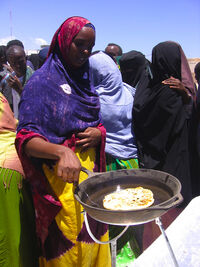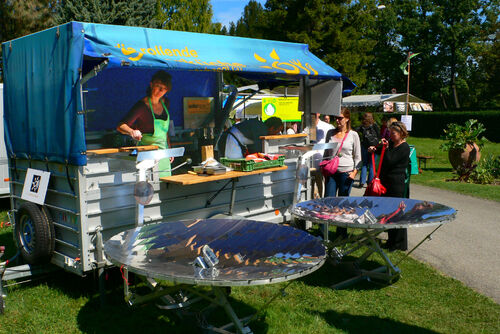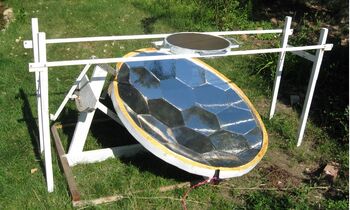Tom Sponheim (talk | contribs) mNo edit summary |
Tom Sponheim (talk | contribs) mNo edit summary Tag: sourceedit |
||
| (8 intermediate revisions by 2 users not shown) | |||
| Line 1: | Line 1: | ||
| + | {{GoogleTranslateLinks}} |
||
| ⚫ | |||
| + | {{Updated|11|4|16}} |
||
| ⚫ | |||
| + | [[Image:Sun_Fire_Cooking_flatbread.jpg|thumb|200px|A woman involved with the [[Sun Fire Cooking]] project cooks [[flatbread]] in a parabolic solar cooker in [[Somalia]].]] |
||
| ⚫ | '''Flatbread''' in its many forms (tortillas, ingera, etc.) is an important staple food around the world. [[Panel cooker]]s and [[box cooker]]s do not get hot enough to cook flatbreads, although they could be specially designed for the purpose. [[Parabolic_reflectors|Parabolic cookers]] are the most likely candidates as well as cookers like the [[Devos Solar Cooker]] and the very large [[Scheffler Community Kitchen]]. |
||
| ⚫ | The Ethiopians and Eritreans use a clay griddle for preparing their ''ingera''. This type of griddle is not conductive enough to allow it to be heated hot enough and evenly enough by most solar cookers. We have received two reports of the use of cast iron griddles made in China. These worked much better than the ones made of clay. When ''ingera'' is cooked in the traditional way over a wood fire, the correct temperature of the griddle is {{Degree|180}}. |
||
| − | The most common type of parabolic solar cooker in the world is likely to be the "butterfly" type with two not-quite-parabolic reflectors. These are very common in China. For more information, see [[Yancheng Sangli Solar Energy]]. |
||
| ⚫ | |||
| − | |||
| + | =={{HeadingNews}}== |
||
| ⚫ | The Ethiopians and Eritreans use a clay griddle for preparing their ''ingera''. This type of griddle is not conductive enough to allow it to be heated hot enough and evenly enough by most solar cookers. We have received two reports of the use of cast iron griddles made in China. These worked much better than the ones made of clay. When ''ingera'' is cooked in the traditional way over a wood fire, the correct temperature of the griddle is 180 |
||
| − | ==Recent news and developments== |
||
[[File:Gallagher_Solar_Injera_Cooker.jpg|thumb|350px|[[Solar Injera Cooker]]]] |
[[File:Gallagher_Solar_Injera_Cooker.jpg|thumb|350px|[[Solar Injera Cooker]]]] |
||
*'''December 2010:''' After he retired, [[Alan Gallagher]], a physicist, decided to take his interest in solar energy in a whole new direction: He decided to design, build, and test a unique large-area frying pan heated by the Sun’s energy. The new parabolic solar frying pan, the [[Solar Injera Cooker]], was specifically tailored to the cooking of injera bread in East Africa. Other types of solar cookers are not well-suited for frying. In villages, a typical “slice” of injera bread can be more than half a meter in diameter. The [[parabolic solar cooker]] can be used eight hours a day throughout the year. [http://jila.colorado.edu/content/incredible-solar-bread-machine More Information...] |
*'''December 2010:''' After he retired, [[Alan Gallagher]], a physicist, decided to take his interest in solar energy in a whole new direction: He decided to design, build, and test a unique large-area frying pan heated by the Sun’s energy. The new parabolic solar frying pan, the [[Solar Injera Cooker]], was specifically tailored to the cooking of injera bread in East Africa. Other types of solar cookers are not well-suited for frying. In villages, a typical “slice” of injera bread can be more than half a meter in diameter. The [[parabolic solar cooker]] can be used eight hours a day throughout the year. [http://jila.colorado.edu/content/incredible-solar-bread-machine More Information...] |
||
| + | |||
==See also== |
==See also== |
||
*[[Solar Injera Cooker]] |
*[[Solar Injera Cooker]] |
||
| Line 13: | Line 15: | ||
*[[Sun Fire Cooking]] |
*[[Sun Fire Cooking]] |
||
*[[Scheffler Community Kitchen]] |
*[[Scheffler Community Kitchen]] |
||
| − | *[[Sabur Achtari]] |
+ | *[[Sabur Achtari]] has built a solar tandori at the [[Afghan Bedmoschk Solar Centre]]. |
==External Links== |
==External Links== |
||
Latest revision as of 18:56, 10 August 2017
|
Last edited: 4 November 2016
|

A woman involved with the Sun Fire Cooking project cooks flatbread in a parabolic solar cooker in Somalia.
Flatbread in its many forms (tortillas, ingera, etc.) is an important staple food around the world. Panel cookers and box cookers do not get hot enough to cook flatbreads, although they could be specially designed for the purpose. Parabolic cookers are the most likely candidates as well as cookers like the Devos Solar Cooker and the very large Scheffler Community Kitchen.
The Ethiopians and Eritreans use a clay griddle for preparing their ingera. This type of griddle is not conductive enough to allow it to be heated hot enough and evenly enough by most solar cookers. We have received two reports of the use of cast iron griddles made in China. These worked much better than the ones made of clay. When ingera is cooked in the traditional way over a wood fire, the correct temperature of the griddle is 180 °C (356 °F).

Michael Götz has taken his 'Crêperie Solaire' to many music festivals or ecology fairs where visitors get their first culinary experience with solar cooking.
News[]

- December 2010: After he retired, Alan Gallagher, a physicist, decided to take his interest in solar energy in a whole new direction: He decided to design, build, and test a unique large-area frying pan heated by the Sun’s energy. The new parabolic solar frying pan, the Solar Injera Cooker, was specifically tailored to the cooking of injera bread in East Africa. Other types of solar cookers are not well-suited for frying. In villages, a typical “slice” of injera bread can be more than half a meter in diameter. The parabolic solar cooker can be used eight hours a day throughout the year. More Information...
See also[]
- Solar Injera Cooker
- Devos Solar Cooker
- Sun Fire Cooking
- Scheffler Community Kitchen
- Sabur Achtari has built a solar tandori at the Afghan Bedmoschk Solar Centre.
